To Guide or Not to Guide: NES Game Atlas (1991, Nintendo of America)
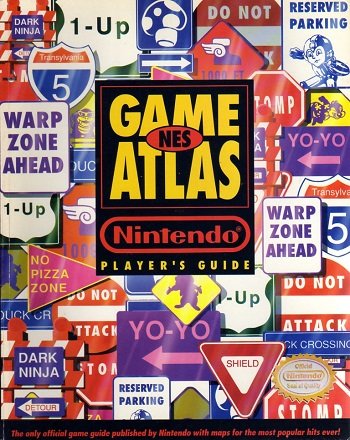
In the days before satellite navigation, cellular phones, and GPS, every driver planning a cross-country voyage knew the most important thing he or she could pack in their car wasn't an extra change of clothing, a set of jumper cables, or even a towel. No, the main thing a road warrior kept in the trunk at all times, no matter the season, was a road atlas.
Often comically oversized, always soft-cover, and frequently stained with age (or possibly coffee), a road atlas was nothing less than the cheat codes for your nation's highways. Armed with a reasonably current one and the ability to read maps, the dedicated driver could make his or her way from southern California to coastal Maine, all without the comforting lilt of a British female voice tut-tutting that you'd just missed your exit five hundred feet back.
Given a road atlas's dedication to making sure you reached your destination by letting you plan your trip in advance and investigate alternate routes and potential problem spots before you saw them out your front windscreen, it's no surprise Nintendo borrowed the terminology for this 1991 publication. Clocking in at 162 pages, just like The Official Nintendo Player's Guide before it, the NES Game Atlas is basically the Official Nintendo Player's Guide, Version 2.0. Where the first book set out to whet your appetite for a plethora of games, by 1991 it was woefully outdated. New franchises had sprung forth to capture the gamers' imaginations, and the amount of software on the market had more than doubled.
The public's appetite no longer needed to be whetted--Nintendo now had tens of thousands of drooling fans eager to devour their carts (hopefully not literally). Now it was time to clear away the appetizers and open the buffet. What Nintendo served up was nothing less than an eighteen-course feast covering not only their biggest hits, but also third-party masterpieces from the likes of Capcom and Konami. Action, adventure, platformers, side-scrolling brawlers, games for kids and adults alike: the NES Game Atlas let you plot your way from the early days of Super Mario Bros. and Castlevania to the most recent incarnations in the Mega Man and Teenage Mutant Ninja Turtles series.
If ever you wanted to not just finish, but dominate, a game, this was the way to plan your route, and Nintendo was perfectly willing to sell it to you either as a free part of your subscription to Nintendo Power magazine, or over-the-counter for one easy payment of $15 US (or $21 in Canada).
To Guide or Not to Guide?
I'm not even going to try to keep readers in suspense. This is the easiest recommendation for a strategy guide I could possibly make. If you're a classic gamer, whether you've owned the system since the 80's or just picked up the NES Classic and want to get the most out of its built-in software, the NES Game Atlas deserves a place of prominence on your bookshelves.
To understand why, let's take a look inside as I desecrate my own copy's spine for these page scans. You're welcome.
What's In It?
This:
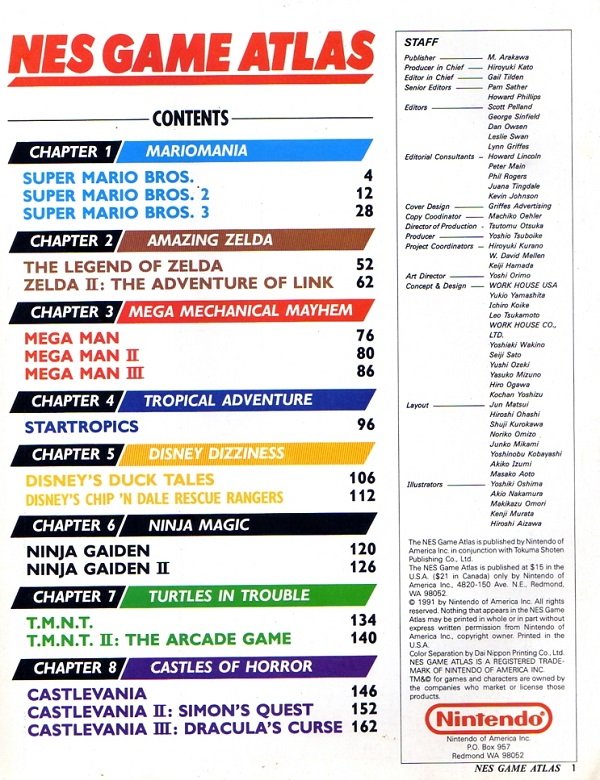
Take a look at that table of contents and one thing should stick out: every last game on that list is not only worth playing, but is a recognized classic of the genre twenty-seven years later. They are titles that top every serious 8-bit gamer's list of 'greatest hits'. If they were songs, you'd see them on every compilation of 80's hits published by Billboard. There's zero fat, no filler, no garbage. Every one of those games is not only worth playing, not only worth beating, but worth completing.
Nowhere in the pages will you see sub-par garbage like Chubby Cherub, licensed claptrap like Popeye, or peripheral-requiring titles like Gumshoe squandering valuable space. Nor do you find Nintendo giving pages to simpler games of skill and memorization--there's no denying Pro Wrestling, Double Dribble, and Excitebike are fun to play, but they all take place in pretty much the same settings with the same characters. An atlas filled with pictures of the same wrestling ring or basketball court isn't nearly as fun as one detailing every corner of the Mushroom Kingdom or Hyrule.
Mapping Your Quest
While the Official Nintendo Player's Guide took you through the first few stages of games like The Legend of Zelda and Castlevania, the Atlas leaves no stone unturned. Using maps painstakingly pieced together with screenshots, or occasionally hand-drawn by staff artists, you get a complete map from start to finish.
And yes, they're not kidding. The Legend of Zelda's second quest? Mapped:
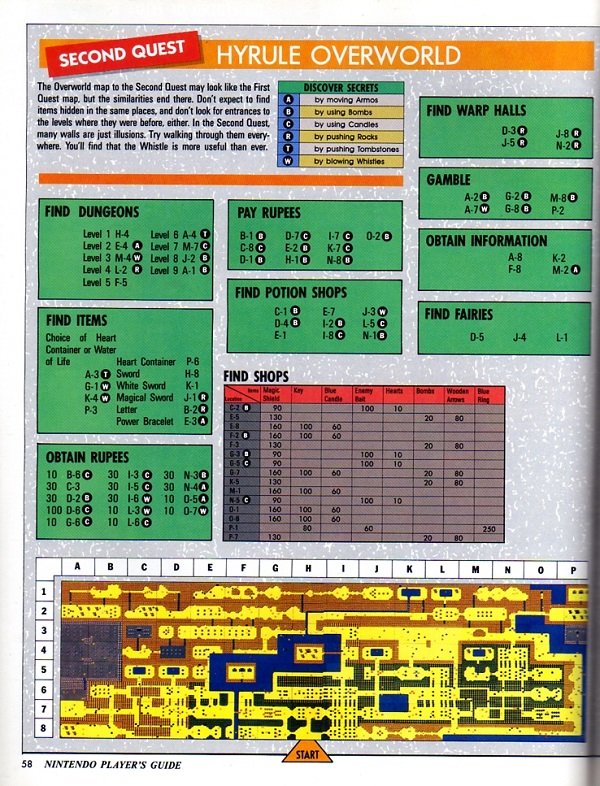
The underwater level from Teenage Mutant Ninja Turtles that gave every gamer rage-quit fits? Here you go:
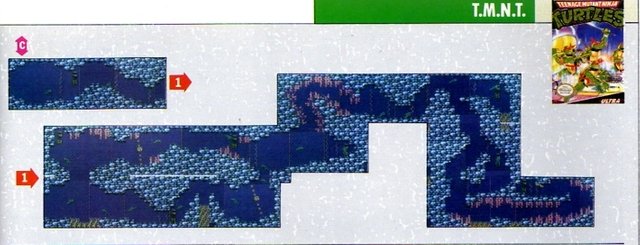
You want power-up locations in Ninja Gaiden, suggested orders for tackling the stages in Mega Man III, or the keys to finding and navigating every mansion in Castlevania II: Simon's Quest? Done, done, and done, my friend.
What's Missing?
Two things, one good and one disheartening in my not-so-humble opinion.
First the good. I raked the Official Nintendo Player's Guide pretty hard for its sometimes-funny, sometimes annoying, sometimes impenetrable Engrish. While it might be picking at low-hanging fruit to make fun of a Japanese company doing its best to impress an entire new world of gamers, it still had to be said the translations often left much to be desired.
You won't find anything of the sort in the NES Game Atlas. No comical misspellings of the company's own name in the letter of introduction, no bizarre usage errors in text boxes, no odd adjective choices when describing enemies. Clearly Nintendo of America had the presence of mind to bring in native speakers for the final editorial passthrough on this one, and it shows.
So what is there to complain about? Well, there's one game so conspicuous by its absence that I remember remarking on it when I first looked at that table of contents at age thirteen. While it's great to see walkthroughs for three Mega Man games, three Mario titles, and three Castlevania carts, Nintendo excluded one of its most complex first-party titles entirely.
Where's Metroid?
It's true Nintendo had covered the bulk of the game in The Official Nintendo Player's Guide a few years earlier, but the same is true of titles like Super Mario Bros. and The Legend of Zelda. If any game deserved the full, complete, and unexpurgated mapping-out received by the other titles in this book, it's Metroid. Samus's absence is the only noted and notable alteration I'd make to this otherwise-perfect tome.
Enough Blabbering! I'm Sold!
I appreciate the enthusiasm, but keep in mind the NES Game Atlas has been out of print for twenty-seven years. I'm not saying it's not worth it, but expect to drop around $30 for it today on the second-hand market. If you've got the cash, and the itch to own one of the most important, most iconic, and most all-around useful strategy guides from the NES era considering ten of the games it covers can be found on the NES Classic system, then yeah, put this book in your shopping cart and hit 'Check Out'.
It's a beautiful tome that holds up nearly three decades later, and even if you don't need it to conquer Bowser's castle in SMB and can find your way through Zelda II's Death Mountain blindfolded while holding the controller upside down, it's fun just to look at and flip through. It'll remind you of the days before speedruns, before the vast resources of the Internet could be brought to bear on every video game problem area in a matter of seconds.
What Came After
Perhaps the most important thing about the NES Game Atlas is that this was one of the last times we'd see Nintendo publish such a wide-ranging gaming guide. They kept publishing strategy guides of course. After the Game Atlas, we saw 'Official Player's Guide'-style books for both the Nintendo GameBoy and the Super Nintendo, and a full-sized historical record of everything Mario.
After that, though? The NES had so many choices on the shelf, and they were getting so much more complex, that they kept the multi-game coverage format inside Nintendo Power and turned their game book division to specific coverage of particular titles. The one game per book format worked very well for the 16-bit era, which saw guides devoted to stomping A Link to the Past, Final Fantasy III, Earthbound, even oddities like Mario Paint and the Super GameBoy peripheral. But this would be one of the last times Nintendo would devote such considerable resources and page counts to multiple amazing 8-bit titles between the covers of a single book.
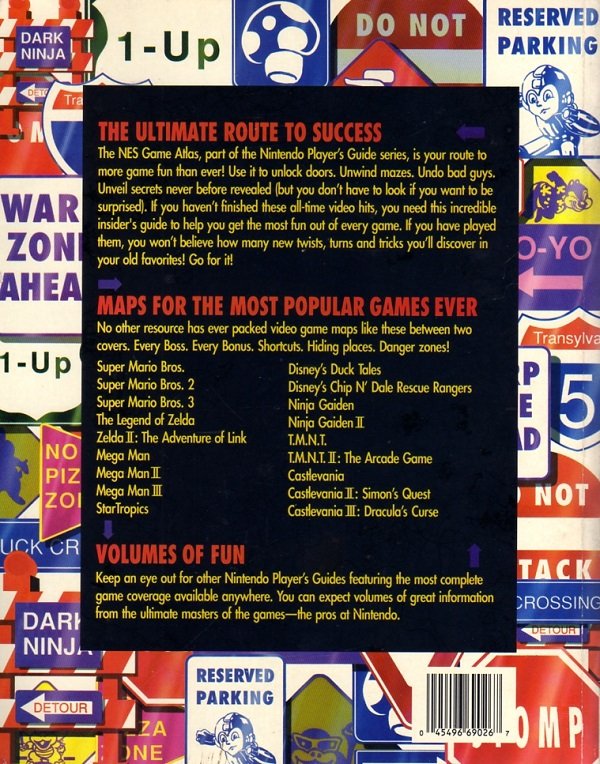
"Volumes of fun" indeed!
Your post was upvoted by the @archdruid gaming curation team in partnership with @curie to support spreading the rewards to great content. Join the Archdruid Gaming Community at https://discord.gg/nAUkxws. Good Game, Well Played!
Great review. I own the previous players guide as a kid and lost it somewhere along the way. I never owned this guide as I had already moved on to 16 bit by the time it was released. But this is a great look at this very cool guide thanks for posting it.
Thanks, @retro-room. It really is a nifty little book. Of the four guides released during this period of Nintendo Power's book publishing days, it's by far the most useful. :)
Congratulations! Your post has been selected as a daily Steemit truffle! It is listed on rank 24 of all contributions awarded today. You can find the TOP DAILY TRUFFLE PICKS HERE.
I upvoted your contribution because to my mind your post is at least 5 SBD worth and should receive 121 votes. It's now up to the lovely Steemit community to make this come true.
I am
TrufflePig, an Artificial Intelligence Bot that helps minnows and content curators using Machine Learning. If you are curious how I select content, you can find an explanation here!Have a nice day and sincerely yours,

TrufflePig